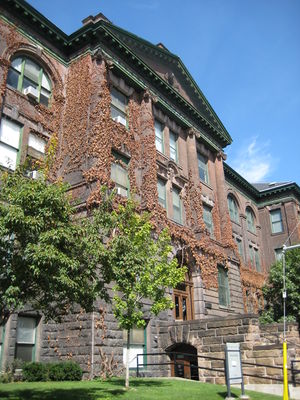Lassonde Mining Building
| Mining Building | |
|---|---|
 | |
| Location | 176 College Street |
| Year Constructed | 1905 |
| Building Code | MB |
| Major Offices/Labs | |
| Lassonde Mineral Engineering Program | |
| Lassonde Institute for Engineering Geoscience | |
| Institute for Biomaterials and Biomedical Engineering | |
The Mining Building at 176 College Street is one of the original buildings of the School of Practical Science. Completed in 1905, the Mining Building was designed by Mr. Francis Riley Heakes and Mr. Frank Darling, Chief Architects of the Public Works Department. The final cost of the building at its completion was $384,736. The building is designated as a Heritage Property for its importance as a major work of Edwardian Classicism.
In 2010, the building began a $20-million renovation project to convert previously unusable attic space into an interdisciplinary design studio.
Departments and Offices
- Lassonde Mineral Engineering Program
- Institute for Biomaterials and Biomedical Engineering
- Canadian Mining Hall of Fame
Notable Laboratories
- Lassonde Institute for Engineering Geoscience
Structure
The Mining building was originally to be a 4-storey structure made of stone and pressed brick. There were to be two wings extending north from the west and east side of the building, enclosing a quadrangle which was to be used as a milling room. Tenders, when received, indicated that the initial building plans were too extravagant – the wings were cut and the design reassessed.
History
The first Mining Engineering Department was established in 1878, and has been located in the Mining Building since its completion in 1905. Today, the Mining Building hosts not only what is now called Mineral Engineering, but also the Lassonde Institute for Engineering Geoscience, and the Institute of Biomaterials and Biomedical Engineering (IBBME). It is also home to one of the original lecture theaters at the university and the Canadian Mining Hall of Fame, that recognizes and honours legendary mine finders and builders who contributed to the growth and development of the industry in Canada.
As the original SPS was administered by the province, it was left to the province to design and build the Mining Building, which initially was to be called the “Minerology and Geology Building”. The initial plan was to accommodate the growing interest in advanced education in mining, and to build a new science building to accommodate the Departments of Minerology, Geology, Metallurgy and Applied Chemistry (in the end, it was called the “Chemistry and Mining Building”). The estimated cost was upwards of $200K, and both the location and design were the subjects of extensive discussion and debate. The building came to represent much more than a science building; it was to play a role as a Toronto landmark.
Before even an initial design was developed, a delegation traveled in search of the perfect building model, and visited other schools of metallurgy and mineralogy in Europe, Canada and the US. Locations visited included Cornel, the University of Pennsylvania, the University of Philadelphia, and Columbia University. The group included Premier Ross, the Hon. Mr. Harcourt, Minister of Education, Hon. F.R. Latchford, Minister of Public Works, Chief Architect F.R. Heakes and Dean Galbraith.
In the fall of 2010, the University, in partnership with the Faculty of Applied Science and Engineering, began a $20-million renovation project of the Mining Building. The project will convert previously unused attic space into the Civil Engineering Department's Interdisciplinary Design Studio, a space that will be used primarily as a "home base" for the fourth-year Civil Engineering design projects. In addition, the space will provide graduate student offices to accommodate graduate student expansion and a convergence area for researchers and industry to collaborate on joint projects. The space will be fully accessible via an interior elevator shaft to be added north of the West stairs. Several offices and labs of Civil Engineering, Mineral Engineering, Mechanical and Industrial Engineering, and IBBME have been displaced for the renovation, some of which will be moved permanently to accommodate the installation of the new elevator.
References
- University of Toronto Archives
- Mail and Empire, September 28, 1901
